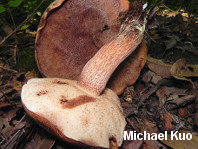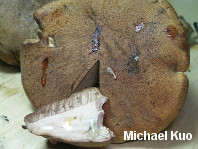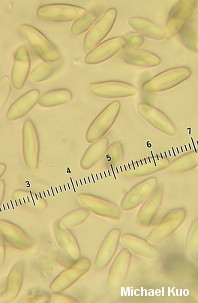| Major Groups > Boletes > Tylopilus > Tylopilus variobrunneus |

|
Tylopilus variobrunneus [ Basidiomycota > Boletales > Boletaceae > Tylopilus . . . ] by Michael Kuo Tylopilus variobrunneus is like a hardwood-loving, mild-tasting version of the well-known Tylopilus felleus (which tastes bitter and associates with conifers). Its stem is prominently reticulate, which separates it from other eastern North American, hardwood-loving species of Tylopilus—like Tylopilus indecisus or Tylopilus ferrugineus, which either lack reticulation or feature only delicate reticulation near the apex of the stem. The colors of Tylopilus variobrunneus are brown, but the precise shade of brown is variable enough that the authors of the species (Roody, Bessette & Bessette, 1998) used Latin for "variable brown" as the species epithet. Description: Ecology: Mycorrhizal with oaks; growing alone, scattered, or gregariously; summer and fall; probably widely distributed east of the Rocky Mountains. The illustrated and described collection is from Illinois. Cap: 5–12 cm; convex when young, becoming broadly convex or nearly flat in age; dry; bald at maturity; medium grayish brown, fading to tan. Pore Surface: Creamy white, becoming pinkish brown; bruising promptly brown; pores circular to angular, 1–3 per mm; tubes to 10 mm deep. Stem: 3–10 cm long; 1–2 cm thick; more or less equal; brownish; reticulate with a fine, brown reticulum; basal mycelium white. Flesh: White; staining slowly brownish when sliced. Odor and Taste: Odor not distinctive; taste mild, not distinctive. Chemical Reactions: Ammonia pinkish orange on cap surface; negative on flesh. KOH dark red to dark gray on cap surface; yellowish to orangish on flesh. Iron salts grayish green on cap surface; bluish on flesh. Spore Print: Brownish pink to pinkish brown. Microscopic Features: Spores 10–13 x 3.5–4.5 µm; subfusiform; smooth; hyaline to yellowish in KOH. Hymenial cystidia fusoid-ventricose; golden in KOH. Pileipellis a collapsing trichoderm; golden in KOH; terminal cells cylindric with rounded or fusiform-cystidioid apices, 2.5–5 µm wide. REFERENCES: Roody, Bessette & Bessette, 1998. (Bessette, Roody & Bessette, 2000; Roody, 2003; Binion et al., 2008.) Herb. Kuo 07231002. This site contains no information about the edibility or toxicity of mushrooms. |
© MushroomExpert.Com |
|
Cite this page as: Kuo, M. (2016, May). Tylopilus variobrunneus. Retrieved from the MushroomExpert.Com Web site: http://www.mushroomexpert.com/tylopilus_variobrunneus.html |


